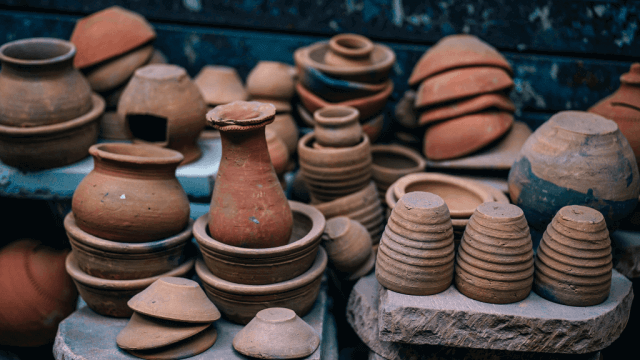Bone China pottery is a type of fine ceramic made from a mixture of kaolin clay, feldspathic material, and bone ash (derived from animal bones) that is fired at high temperatures to achieve a high level of translucency, strength, and whiteness. It is known for its unique appearance, delicate nature, and its intricate surface decorations, making it a luxury choice for tableware and ornamental pieces.
Introduction to Bone China Pottery
Bone China pottery is a type of high-quality ceramic that is prized for its delicate appearance, translucency, and overall beauty. Often used for tableware and decorative items, it is one of the most prestigious types of ceramics that a potter can create.
Composition of Bone China
Bone China pottery is a unique blend of materials that come together to achieve its telltale attributes during the firing process. The formula typically consists of:
- Kaolin Clay – A primary ingredient in most porcelains, giving durability and structural integrity.
- Feldspathic Material – Provides ease of shaping and vitrification during firing.
- Bone Ash – Derived from calcined animal bones and responsible for the lightweight, translucency, and whiteness of Bone China.
Vitrification and Firing Process
The firing process is crucial to attaining the unique qualities of Bone China pottery. A two-step firing process is employed:
- Bisque Firing – The first firing occurs at a lower temperature (around 1200-1300°C), allowing the piece to harden while remaining porous.
- Glost Firing – The piece is coated with a clear glaze and fired again at a higher temperature (around 1250-1450°C) causing vitrification, making the pottery translucent and glass-like.
Characteristics of Bone China Pottery
Several factors set Bone China apart from other types of ceramics:
- Translucency – A defining feature, this is achieved through high bone ash content and vitrification during firing.
- Whiteness – The unique white color is due to the bone ash, making it visually distinct from other ceramic types.
- Strength – Despite its delicate appearance, Bone China is remarkably strong owing to its high kaolin content and vitrification process.
- Design Versatility – The smooth, white surface makes it an ideal medium for intricate decorations, including hand-painted designs, enameling, and gold or platinum gilding.
Caring for Bone China Pottery
Preserving the exquisite beauty of Bone China pottery calls for special care:
- Washing – Hand-washing is recommended using mild soap; avoid abrasive detergents or scrubbers.
- Handling – Take care not to stack pieces too tightly or knock them against each other to prevent chipping and breakage.
- Temperature – Avoid sudden temperature changes, as they could cause cracking.
- Storing – Ensure proper padding between pieces to protect from scratches and chipping.
History of Bone China Pottery
Bone China’s origins can be traced back to 18th-century England, where it was first developed by Josiah Spode. Spode sought to create an enhanced ceramic material that combined the aesthetics of Chinese porcelain with the practical attributes of European hard-paste pottery. The result was Bone China, which quickly gained a reputation for elegance and quality, making it highly coveted worldwide.
Notable Manufacturers and Collectible Bone China
Over the centuries, several manufacturers have been acclaimed for their exceptional craftsmanship and artistry in producing Bone China pottery:
- Spode – Known as the inventors of Bone China, their pieces remain popular among collectors.
- Royal Doulton – An English brand that has produced intricate, hand-painted artworks and tableware since 1815.
- Wedgwood – With a rich heritage dating back to 1759, Wedgwood has created diverse and innovative designs.
- Noritake – Though originally from Japan, this company is recognized for its beautifully crafted Bone China products, combining Eastern and Western influences.
The Environmental Impact of Bone China Pottery
While Bone China pottery is admired for its beauty and quality, it is essential to also consider its environmental impact:
- Resource Consumption – The production process requires significant amounts of mined raw materials, including kaolin and feldspar, which can deplete natural resources.
- Energy Use – The high-temperature firing process necessitates considerable energy consumption, contributing to greenhouse gas emissions and global warming.
- Animal Byproducts – As the name implies, Bone China contains bone ash derived from animal bones, raising ethical concerns for animal welfare and environmental degradation linked to livestock farming.
- Waste Production – The manufacturing process may generate waste and pollution, including potentially hazardous substances from mining and processing, which can negatively impact nearby ecosystems.
Considering these issues, it is worthwhile to explore environmentally friendly alternatives like recycled ceramics and other sustainable materials. However, for those who cherish Bone China pottery, proper care and preservation will ensure that these pieces can be enjoyed by future generations.
FAQ Section
In this section, we address some frequently asked questions about Bone China pottery, shedding light on its unique attributes, the significance of bone ash content, and tips for care and maintenance.
What are the main differences between Bone China and Porcelain?
Bone China is a type of porcelain created from a unique blend of materials, including bone ash. Its hallmark characteristics include translucency, whiteness, and a delicate appearance. Porcelain lacks bone ash, tends to be less translucent, and is generally heavier and more dense than Bone China.
How do I identify genuine Bone China?
To identify genuine Bone China pieces, perform a few simple tests: hold the piece against light to examine its translucency, as genuine Bone China will allow light to pass through; tap it gently to listen for a light ringing sound, typical of Bone China; and, when in doubt, check for manufacturer’s marks or stamps on the base that can help verify its authenticity.
Can Bone China be used in the microwave or dishwasher?
Although Bone China is surprisingly durable, it is best to avoid using it in the microwave, particularly if it has metallic decorations like gold or platinum, which can cause damage. For washing, it is recommended to hand-wash Bone China using gentle soap and a soft cloth to preserve its delicate beauty and avoid chipping or cracking.
Is there an animal-free alternative to Bone China?
For those who prefer not to use animal byproducts, there are other types of ceramics that offer similar qualities to Bone China but are bone ash-free. One such example is Fine China, which maintains a delicate appearance and a bright white color without the use of bone ash in its composition.
Can I repair chipped or cracked Bone China?
While it is challenging to restore a chipped or cracked Bone China piece to its original condition, professional ceramic restorers can often undertake repairs that may minimize the damage. However, it is essential to use proper care and handling techniques to prevent any further damage and preserve the value and beauty of the piece.











